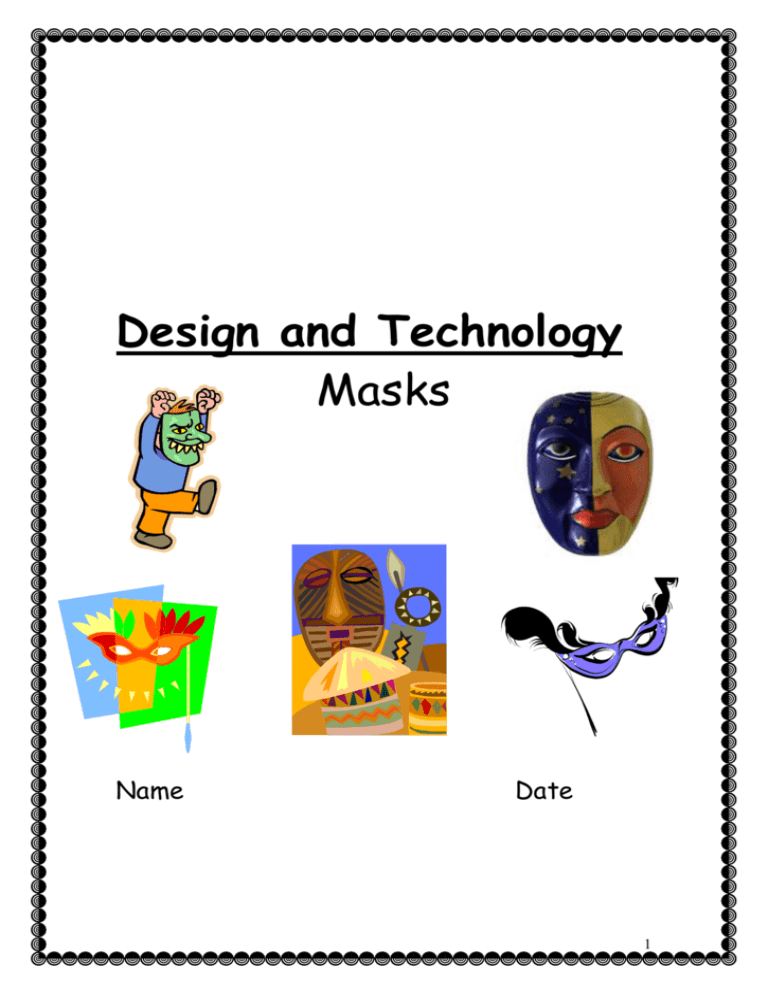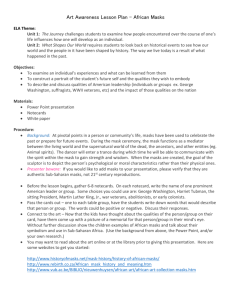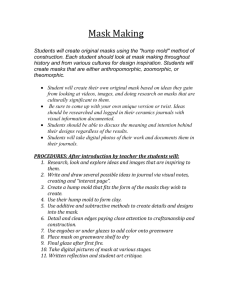Design and Technology
advertisement

Design and Technology Masks Name Date 1 Investigation and Research Researching Learning Objectives; ¤ To know that products are designed for different purposes and users. ¤ To evaluate products and identify ideas to use in our own work. ¤ To make labelled diagrams from different view showing specific features. (It is assumed that children will have been given research time at home or on the internet prior to starting this section) ¤ ¤ ¤ ¤ Look at your research and masks provided. Draw 3 different masks, each mask needs to be drawn from 2 different angles For each mask you need to label any design features – 3-d effects, attachments, logo’s etc. Label fastening and joining techniques (e.g how is the mask attached to the head?) and don’t forget to measure your masks. . 2 Investigating Learning Objectives: ¤ To know that products are designed for different purposes. ¤ To know that the products purpose affects the materials used. Using your work from the previous session with your partner answer the following questions: ¤ Which materials are used to make the masks you have seen? ¤ Which masks are most suitable for young children? ¤ What reasons do people use masks? ¤ What special effects/designs can you see? ¤ List features that you think are essential to all masks? ¤ List all the different ways masks can be attached that you have noticed. ¤ Which design features from the masks might you want to use in your own design? ¤ Why have you chosen this feature? 3 Testing and Modelling Learning objectives: ¤ To know how to assemble various components. ¤ To know that materials have different properties. ¤ To realise some joining techniques are stronger/weaker than others. ¤ That materials can be joined in temporary ways. 1. 2. 3. In the boxes draw 3 of the different ways masks can be attached to a persons head that you could use. Which one is the safest and most practical for your design?Why? Durability tests Think about the materials you have available to make your mask, which are the most durable? Which are practical? Which will wear easily? E.g: Fabric, laminated card, Board, paper, beads. Which material would you use? Why? Which material wouldn’t you use? Why? 4 Generating a Design Thought Shower and Design Brief Learning objectives: ¤ To know that products are designed for a specific purpose or audience in mind. ¤ To appreciate the aesthetic qualities of a design. You are going to design a mask for a set purpose. You need to decide Who/what purpose you are going to design your mask for? E.g: Halloween party, fancy dress ball. Think carefully about this. This is called your design brief. My brief is: ………………………………………………………………………………………………………………………… …………………………………………………………………………………………………………….. You can now use the brief to help you think about what your mask must achieve to be successful and meet the brief. This will inform your design. Pattern Colour Shape Who/What for? 3D effects 5 What must your mask do to be successful and meet the design specification? How will you meet your users’ needs? Which materials will you use?Why? How will you attach the pieces of your mask together? How will you make your mask aesthetically pleasing? 6 Design Ideas Learning Objectives: ¤ To help design a product for a specific purpose or audience. ¤ To communicate ideas. ¤ To appreciate the aesthetic qualities of design. ¤ To draw simple design specifications. Now you need to design 3 different masks. Remember to think about your design brief, important features such as materials, suitability for the person, occasion and use your imagination. Be Creative !!!!!! Label the materials and features of your mask in detail, showing any joins. Mask 1 Design features: Mask 2 Mask 3 7 Final decision Now you have designed three masks you need to decide with the rest of your group which set you are going to make. Look at your designs again and think carefully about which one fulfils you design brief best, is suitable for you audience and is creative. You may need to have a vote if you cannot decide. You need a detailed diagram that includes the way you will join your mask together and what details you will add. Don’t forget to show any decorative details you intend to have. Final design I have chosen to make this mask because …………………………………………………………… …………………………………………………………… …………………………………………………………… …………………………………………………………… …………………………………………………………… ……………………………. 8 Planning Planning to make Learning objectives: ¤ To make a plan of how to make the product. ¤ To know how to make a paper pattern/template. ¤ To measure and cut from a pattern with some accuracy. Now you need to plan how you will make your mask. How will make the shape of them consistent? This means how you will keep them all the same. Make a template of the shape of your mask from paper. This must be to scale. Think back to the testing and modelling stages and write a list of materials and equipment you will use. Materials I will use Equipment I will use Making Learning objectives: ¤ To be able to use simple decorative techniques. ¤ That fabric can be joined in temporary ways. ¤ To measure, pin, cut and join fabric with some accuracy You are now ready to begin making your mask. 9 Evaluation Evaluating your design Learning objective: ¤ To evaluate your own product identifying any strengths and any areas for development against the original specifications ¤ To identify any changes you would make if you repeated the task. What would you say are the strengths of your Mask? Does your mask meet your original criteria? How? Did you change anything during the making process? What? Was it hard to make? Why/ why not? Are you pleased with your finished product? Why? How could you make it better? Well done! 10








